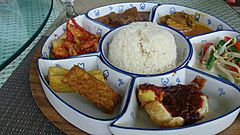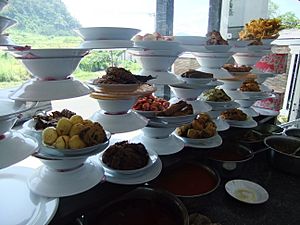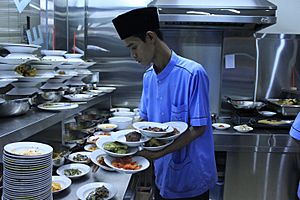Nasi padang facts for kids

Nasi padang
|
|
| Type | Rice dish |
|---|---|
| Course | Main course |
| Place of origin | Indonesia |
| Region or state | West Sumatra |
| Serving temperature | hot or room temperature |
| Similar dishes | Nasi kapau, nasi campur |
Nasi padang, also known as Padang rice, is a famous meal from West Sumatra, Indonesia. It's a plate of steamed rice served with many different pre-cooked dishes. This delicious food comes from the Minangkabau people, who live in West Sumatra.
The name "Nasi padang" comes from the city of Padang. This city is the capital of West Sumatra province. Imagine a small feast of meats, fish, vegetables, and spicy sauces called sambal. All these are eaten with plain white rice. It's one of Sumatra's most well-known foods. It is also a big part of what the Minangkabau people have given to Indonesian cuisine.
You can usually spot a Padang restaurant easily. They often have a special roof style, like a traditional Rumah Gadang house. Their windows show off many dishes. You'll see rows of carefully stacked bowls and plates. These are filled with all sorts of tasty food. Many smaller Padang restaurants have names in the Minang language.
Nasi padang is a very important lunch for workers in Indonesian cities. It's so popular that when its prices went up in 2016, government workers even asked for more food money! You can find Nasi padang in many cities across Indonesia. It is also popular in nearby countries like Malaysia, Singapore, and Australia.
Contents
How Nasi Padang is Served
Padang restaurants use two main ways to serve their food. These are called pesan (ordering) and hidang (serving).
The Pesan Method
The pesan method is the most common way to order. Smaller restaurants often use it when only a few customers are there. You look at the dishes displayed in the window. Then, you tell the waiter what you want to eat. The waiter quickly brings your chosen dishes to your table.
The Hidang Method
Larger Padang restaurants often use the exciting hidang method. This way of serving is perfect for groups of people. When you sit down, you don't need to order anything. Waiters will immediately bring many dishes to your table. They carry stacks of plates in their hands.
Your table will quickly be covered with dozens of small dishes. These might include beef rendang, curried fish, and stewed greens. You might also see chili eggplant, curried beef liver, or fried chicken. Spicy sauces called sambal are always on the table. Usually, about twelve different dishes are served this way.
When Nasi padang is served hidang style, it's like a buffet right at your table. You only pay for the dishes you actually eat from the many choices.
Eating with Hands
In Minang restaurants, it's common to eat with your hands. A bowl of water with a slice of lime, called kobokan, is given to you. You use it to wash your hands before and after eating. If you prefer not to eat with your hands, it's perfectly fine to ask for a spoon and fork.
Popular Nasi Padang Dishes
Steamed rice is usually served with gulai cubadak. This is a curry made from unripe jackfruit. Boiled cassava leaves are also often served. Nasi padang dishes are quite similar to those found in nasi kapau from Bukittinggi. The main difference is how they are served. Here are some popular dishes you might find:
- Gulai cubadak: Unripe jackfruit curry.
- Sayur daun ubi kayu or sayur daun singkong: Boiled cassava leaves.
- Rendang: Chunks of beef cooked slowly in spicy coconut milk until dry. You can also find chicken or duck rendang.
- Kalio: Similar to rendang, but it's more watery and lighter in color.
- Gulai ayam: Chicken curry.
- Gulai cancang: Curry made with meats and cow internal organs.
- Gulai tunjang: Curry made from cow foot tendons.
- Gulai babek or gulai babat: Curry made from cow tripes.
- Gulai iso or gulai usus: Curry made from cow intestines, often filled with eggs and tofu.
- Gulai kepala ikan kakap merah: Red snapper's head curry.
- Gulai jariang: Curry made from jengkol stinky beans.
- Dendeng batokok: Thin, crispy beef.
- Dendeng balado: Thin, crispy beef with chili.
- Paru goreng: Fried cow lung.
- Ayam bakar: Grilled spicy chicken.
- Ayam goreng: Fried chicken with spicy granules.
- Ayam pop: A special Minang-style chicken, first boiled or steamed, then lightly fried.
- Ikan bilih: Fried small freshwater fish.
- Baluik goreng: Crispy fried small freshwater eel.
- Udang balado: Shrimp in chili.
- Terong balado: Eggplant in chili.
- Petai goreng: Fried green stinky beans.
- Ikan asam padeh: Fish with a spicy-sour taste.
- Peyek udang: Shrimp crackers.
- Kerupuk jangek: Cow's skin crackers.
- Sambal balado: A spicy sauce with large sliced chili peppers.
Nasi Padang in Pop Culture
In 2016, a singer from Norway named Audun Kvitland Røstad wrote a song about his love for Padang rice. The music video for this song became very popular online.




